How to Communicate Online in 2026: 9 Tools to Try
Running a business in the modern competitive world is hard enough. Enabling flawless online communication with internal and external stakeholders shouldn’t add to your troubles.
But the fact is, by 2026, online communication will feel even more demanding than it does today. Customers will expect faster replies, while business teams will need smoother collaboration. As such, small businesses will continue to face the same challenge: keeping people and processes moving smoothly without burning out.
Most growing service providers don’t have big budgets or complex IT systems to fall back on. They rely on communication tools that are easy to use, affordable, and reliable. But the real struggle is knowing which ones are worth their time.
This post will highlight nine tools that can actually help. They’re built to simplify internal and external communication, minimize confusion, and give small businesses a fair chance to grow without constant miscommunication.
9 Online Communication Tools to Use in 2026
Here are nine tools that we recommend using in the upcoming year to make your online communication flawless and glitch-free.
1. Murf AI

Murf is a suite of state-of-the-art AI voice tools that allow businesses and individual users to produce studio-quality audio without the need for expensive gear or soundproof studios. In fact, it can be used by anyone who wants to sound professional in online meetings, training presentations, podcasts, or client-facing content. It is widely known for its advanced yet easy-to-use text-to-speech capabilities. But beyond that, Murf makes voice communication more flexible and engaging for modern teams.
Standout communication features
Ability to instantly change your voice in real time for calls, podcasts, or videos
200+ AI-generated voices that sound realistic in 20+ languages with multiple accents and styles
Control your voice with adjustable pitch, tone, and modulation settings
Voice cloning for creating a consistent audio brand identity
Editing tools that sync voice with presentations or visuals
Pricing: Free plan available. Paid plans begin with Creator, priced at $19 per month. The Business plan costs $66 per month. Murf also offers custom pricing for the Enterprise plan.
2. Slack
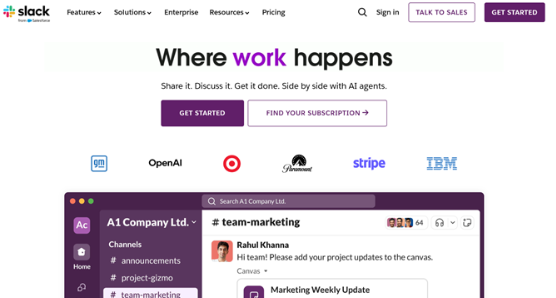
Slack ranks among the most renowned tools for workplace communication for a reason. It is especially popular among small and growing businesses. Users can say goodbye to never-ending email chains and use this tool to collaborate in real time instead. It can facilitate daily chats, quick updates, project tracking, and even client communication in shared channels. The platform has earned its reputation as a “digital office” where work conversations naturally happen.
Standout communication features
Topic-specific channels that keep discussions focused
Quick file and link sharing in chat
Integration with tools like Google Drive, Asana, and Zoom
Powerful search to find old conversations and files without hassle
Pricing: Free plan available for small teams. Paid plans start at $8.75 per user per month.
Bonus: A common concern related to sending out business messages to customers is that they sound like robotic, machine-generated text. Fortunately, you can now humanize AI content with a click of a button. This tool works by making machine-written text sound 100% human-like, authentic, and relatable. It comes with some helpful communication features of its own:
Converts text produced using ChatGPT, Gemini, Grok, Claude, DeepSeek, Jasper, QuillBot, Grammarly, or any other AI text generator
The AI-to-human text converter rewrites AI content with a conversational tone that feels human
Enhances precision in customer-facing messages, emails, and chat responses
Customizable levels of rewriting for different communication needs
Helps businesses scale communication without losing authenticity
3. Zoom Meetings

Zoom is a trusted video conferencing tool that allows users to “connect, collaborate, and get more done together with trusted video meetings.” Whether you need to get on one-on-one calls or partake in larger webinars, Zoom can make it happen flawlessly, thanks to its stability and ease of use.
Standout communication features
High-quality video and audio
Screen sharing for presentations or training
Breakout rooms for group discussions
Recording options for training or future reference
Pricing: The Basic plan is free. Paid plans start at $16.99 for 30-hour-long meetings with 100 participants.
4. Microsoft Teams
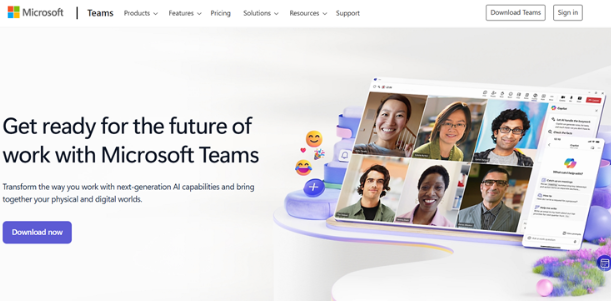
This is one app that merges chat, video, and document collaboration over a single platform. This means it’s highly convenient and useful, especially for businesses already using Microsoft 365. In fact, many small businesses use it as their default tool for communicating and file-sharing.
Standout communication features
More impactful meetings with features like PowerPoint Live, Microsoft Whiteboard, and AI-generated meeting notes
Make and receive calls with features like group calling, voicemail, and call transfers
Keep everyone in sync via channels, shared task lists, and collaborative apps
Chat expressively using emojis, suggested replies, and Microsoft Loop components
Secure file storage and sharing backed by Microsoft’s cloud services
Pricing: Free version available. Paid plans start at $4 per user per month as part of Microsoft 365.
5. Google Meet
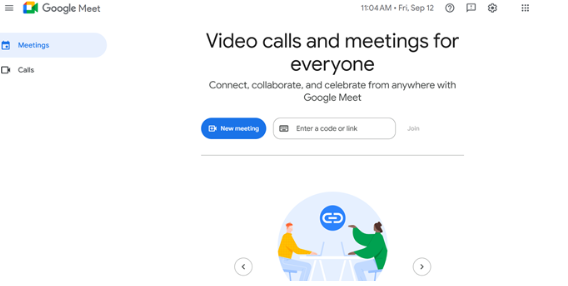
Google Meet packs a punch with its secure, high-quality video calling features. Whether you’re collaborating with your team or scheduling a one-on-one with a colleague, you’ll have several features to choose from. This includes noise cancellation, automatic light adjustment, and real-time captions. You can also incorporate fun effects, filters, reactions, and backgrounds into casual, light-hearted meetings.
Standout communication features
Reliable video calls that run directly in the browser
Call features include shared whiteboard, reactions, polls, voting, and Q&A
Easy integration with Google Calendar and Google Contacts for one-click meeting calls
Screen sharing, browser tabs sharing, and Google document/spreadsheet/presentation sharing
Pricing: Free plan available. Paid plans come as part of Google Workspace, starting at $6 per user per month.
6. WhatsApp Business
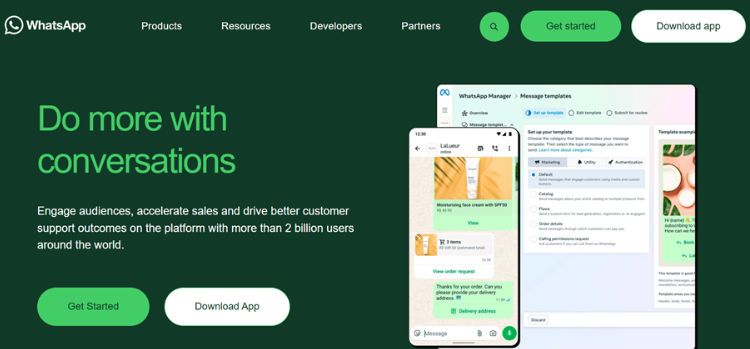
Small businesses that use WhatsApp to talk to customers can use an upgraded version built especially for them. WhatsApp Business allows users to create a business profile, send quick replies, and organize chats with dedicated labels. Customers can use native entry points like a custom button on your website or a QR code on your product packaging to start conversations with you.
Standout communication features
Send files, images, and locations with media messages
List Messages or Reply Buttons to structure responses or provide a clear call-to-action
Accept payments for orders within the app
Automate replies and customer support with chatbots
Pricing: Free to use
7. Signal
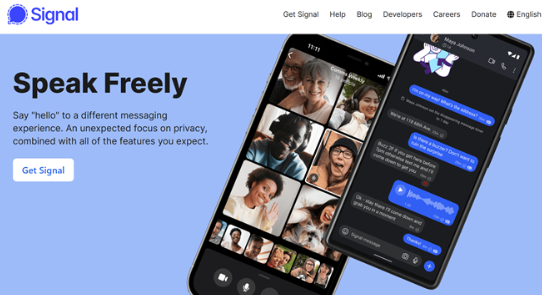
Signal enables personal as well as professional communication with maximum privacy. Users can choose from video calls, group chats, voice messages, and photos, videos, and file sharing. Even though it is an open-source platform, all of its features are protected with end-to-end encryption. Further, sender details are “sealed,” with no messages or metadata being stored on Signal servers. This high level of security is a key reason it is used by US government officials.
Standout communication features
Sophisticated end-to-end encryption for messages and calls
Voice and video calls with clear audio across countries and continents
No ads, no affiliate marketers, and no tracking
Disappearing messages
Send stickers and GIFs securely
Pricing: Free to use
8. Telegram
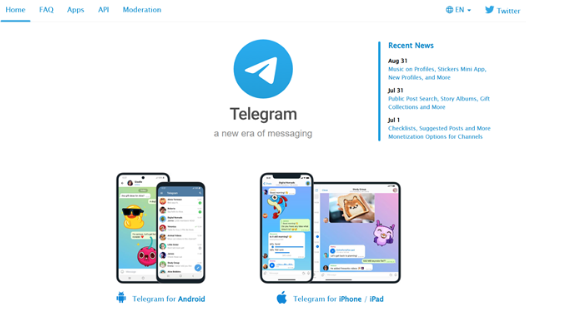
Telegram is a messaging app with a focus on speed and security. Users can use it on all their devices at the same time. It allows you to send messages, photos, videos, and files in any format, including Doc, Zip, MP3, and more. Users can also create groups for up to 200,000 people or channels and start broadcasting to unlimited audiences.
Standout communication features
Cloud-based messaging that’s easy to use
Messages are heavily encrypted and can self-destruct
Open API and source code are free for everyone
No limits on the size of your media and chats
Searchable messages and media
Pricing: Free to use
9. Zoho Cliq
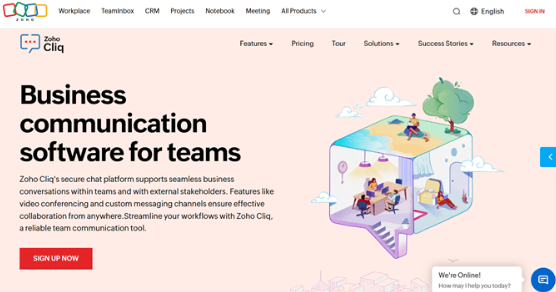
Zoho Cliq is a “team communication tool.” It serves as a secure chat platform that supports seamless conversations within teams and with external stakeholders. Users get features like video conferencing and custom messaging channels that enable hassle-free collaboration, regardless of their location. Chat, make voice or video calls, and share your screen because Zoho Cliq can make it all happen from one place.
Standout communication features
Create channels to organize conversations by topic or project
Real-time chat with channels and direct messages
Integrations with Zoho apps and other third-party tools
Emoji reactions and reminders for messages
Bots for automation and workflow support
Pricing: A Free plan is available for basic features. Paid plans start at $2 per user per month.
Conclusion
All businesses, irrespective of their size, need practical communication tools to get their messages across to their employees, customers, and stakeholders. The tools mentioned above are some of the most widely used and proven ones used by all kinds of businesses.
Features such as secure online chat, video conferencing, voice changing, etc., can take communication to the next level for businesses looking to stand out in the overcrowded market. Moreover, text humanizers can add the much-needed human touch to every message sent out.
If your business is on the lookout for reliable online communication tools, make sure to choose one based on your unique needs and budget. The right one will surely hold you in good stead.





